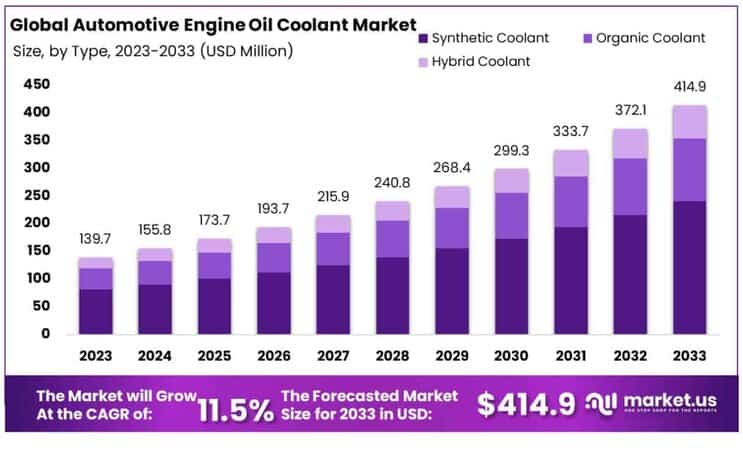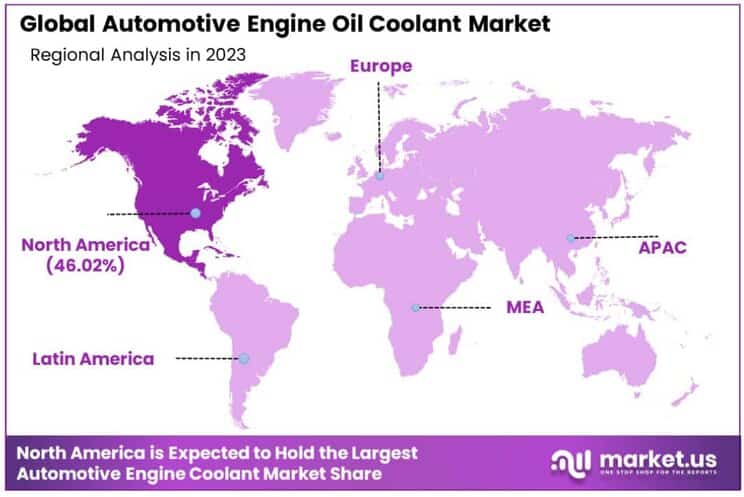Table of Contents
Introduction
The Global Automotive Engine Oil Coolant Market is projected to reach a value of approximately USD 414.9 million by 2033, up from USD 139.7 million in 2023, representing a compound annual growth rate (CAGR) of 11.5% during the forecast period from 2024 to 2033.
The automotive engine oil coolant market encompasses the products used to regulate the temperature of an engine’s oil, preventing overheating and ensuring optimal engine performance. Engine oil coolants are designed to maintain the engine oil at a stable operating temperature, enhancing the lifespan of the engine by reducing wear and preventing potential damage caused by excessive heat.
The market for automotive engine oil coolants is driven by several factors, including increasing vehicle production, rising consumer demand for vehicle longevity, and advancements in automotive technology. As the automotive industry continues to evolve, particularly with the growing trend of electric vehicles (EVs) and hybrid vehicles, the need for efficient and high-performance engine coolants is gaining traction.
Furthermore, stricter environmental regulations and rising awareness about vehicle maintenance contribute to the increasing adoption of advanced cooling systems. The demand for engine oil coolants is particularly strong in regions experiencing rapid industrialization and urbanization, where automotive ownership rates are growing. The market also benefits from the rising trend toward longer vehicle lifespans and improved fuel efficiency, both of which are positively impacted by effective cooling systems.
Opportunities in this market lie in the development of eco-friendly and high-performance coolants, as well as innovations that cater to the specific needs of electric and hybrid vehicles, which operate at different temperature ranges compared to traditional combustion engines. Additionally, the growing focus on aftermarket automotive parts and services provides a promising avenue for growth within the engine oil coolant market.

Key Takeaways
- The Automotive Engine Oil Coolant Market was valued at USD 414.9 million in 2023. It is anticipated to decrease to USD 139.7 million by 2033, reflecting a compound annual growth rate (CAGR) of 11.5%.
- Synthetic coolant held a dominant position in the market, accounting for more than 58.03% of the total market share in 2023.
- The passenger car segment emerged as the dominant market category, capturing over 76.2% of the total market share.
- The automotive aftermarket held a significant share of the market, accounting for more than 80.9% of the total market share in 2023.
- Propylene glycol maintained a leading market position, holding more than 63.7% of the market share in 2023.
- North America emerged as the leading region in 2023, holding a dominant market share of 46.02%.
Report Scope
| Report Features | Description |
|---|---|
| Market Value (2023) | USD 139.7 Million |
| Forecast Revenue (2033) | USD 414.9 Million |
| CAGR (2024-2033) | 11.5% |
| Segments Covered | Type(Synthetic Coolant, Organic coolant, Hybrid coolant), Vehicle type(Passenger cars, Commercial cars), Distribution channel(Automotive Aftermarket, Original Equipment Manufacturer), Product(Propylene glycol, Ethylene glycol, Glycerine) |
| Competitive Landscape | MAHLE GmbH, Dana Incorporated, Castrol, Fluidyne Control Systems pvt ltd, Titanx Engine Cooling Inc, PWR Holdings, Setrab, Amsoil Inc, Blue Star Lubrication Technology, Valvoline, Royal Dutch Shell, Chevron Corporation |
Emerging Trends
- Adoption of Environmentally Friendly Coolants: A growing shift towards biodegradable and eco-friendly engine oil coolants is evident as consumers and manufacturers focus on reducing environmental impact.
- Technological Advancements in Coolant Formulations: Development of more efficient, high-performance coolants, such as those with extended temperature range capabilities, is gaining traction in response to increasingly stringent vehicle performance standards.
- Integration of Multi-Function Coolants: New oil coolants that serve multiple purposes, including enhanced lubrication and corrosion prevention, are becoming popular in automotive applications, aiming to optimize engine efficiency and longevity.
- Synthetic Coolants Surge: The preference for synthetic engine oil coolants is growing due to their superior performance characteristics, such as higher thermal stability and longer service life compared to conventional coolants.
- Increased Focus on Electric Vehicles (EVs): With the rise in electric vehicles, there is a growing need for specialized coolants that can efficiently manage the heat generated in EV battery systems, thus driving innovation in the automotive coolant sector.
Top Use Cases
- Conventional Internal Combustion Engine (ICE) Vehicles: Automotive engine oil coolants are primarily used to regulate the temperature of the engine, enhancing its longevity and performance in traditional vehicles.
- Electric Vehicles (EVs): Specialized coolants are increasingly used in electric vehicle systems, particularly for cooling batteries and inverters, to prevent overheating and enhance energy efficiency.
- Heavy-Duty Vehicles: Trucks and buses, which operate under extreme conditions, require high-performance engine oil coolants capable of maintaining engine stability even in demanding environments.
- Racing and Performance Vehicles: High-performance vehicles, including those used in motorsports, demand custom-engineered oil coolants to ensure optimal engine performance and protection under high-stress conditions.
- Industrial and Commercial Equipment: In addition to vehicles, various industrial machinery and commercial equipment also utilize engine oil coolants for efficient heat dissipation in heavy-duty engines.
Major Challenges
- Fluctuating Raw Material Prices: The prices of key raw materials used in engine oil coolants, such as glycol, have been volatile, which can impact production costs and overall market stability.
- Stringent Regulatory Compliance: Manufacturers face challenges in meeting the increasingly strict regulatory standards for coolant formulations, particularly in terms of environmental sustainability and toxicity.
- Consumer Awareness: A significant barrier to market growth is the lack of awareness among end users about the importance of using the right coolant for engine efficiency, which could lead to improper maintenance or coolant selection.
- Compatibility Issues: Incompatibility between new-generation coolants and older engine systems remains a concern, limiting the adoption of newer coolants in the replacement market.
- Risk of Overheating and Coolant Failure: If engine oil coolants are not properly maintained or replaced, there is a risk of overheating, which can cause engine damage, resulting in increased repair costs and potential safety hazards.
Top Opportunities
- Eco-Friendly and Sustainable Products: As environmental concerns rise, there is a significant opportunity for manufacturers to develop and market coolants that are biodegradable and non-toxic, catering to the growing eco-conscious consumer base.
- Advanced Coolant Solutions for Electric Vehicles: With the increasing adoption of electric vehicles, there is an opportunity for the development of specialized coolants that meet the specific thermal management needs of EVs, especially in relation to batteries and electric drivetrains.
- Product Innovation in High-Performance Coolants: The development of high-performance coolants, such as those that offer enhanced heat dissipation or extended service intervals, presents an opportunity for differentiation in the competitive automotive market.
- Emerging Markets Growth: As automotive production and sales grow in emerging markets, there is an opportunity to tap into the growing demand for automotive lubricants and coolants, driven by increased vehicle ownership.
- Focus on Preventative Maintenance Solutions: Offering coolant systems that can detect potential failures or performance issues early on, thereby reducing the risk of engine damage and improving vehicle reliability, represents a growing opportunity in the automotive sector.
Key Player Analysis
The competitive landscape of the global automotive engine oil coolant market in 2024 is characterized by a strong presence of established industry players, each contributing unique capabilities to the sector. MAHLE GmbH and Dana Incorporated stand out for their robust engineering expertise, particularly in developing advanced cooling systems that enhance engine performance and efficiency. Castrol, Valvoline LLC, and Royal Dutch Shell dominate the lubricant segment, leveraging their extensive distribution networks and strong brand equity to offer high-performance products.
Fluidyne Control Systems Pvt Ltd, TitanX Engine Cooling Inc, and Setrab are recognized for their specialized solutions in thermal management and innovative cooling technologies, addressing the growing demand for eco-friendly and energy-efficient automotive components. Additionally, PWR Holdings and Amsoil Inc continue to lead in providing custom, high-performance coolants for niche markets, while Chevron Corporation’s broad portfolio ensures its competitive positioning across multiple market segments. These players collectively shape the evolving dynamics of the market, emphasizing technological advancements and sustainability.
Top Market Key Players
- MAHLE GmbH
- Dana Incorporated
- Castrol
- Fluidyne Control Systems pvt ltd
- Titanx Engine Cooling Inc
- PWR Holdings
- Setrab
- Amsoil Inc
- Blue Star Lubrication Technology
- Valvoline LLC
- Royal Dutch Shell
- Chevron Corporation
Regional Analysis
In 2024, North America is expected to dominate the Automotive Engine Oil Coolant Market, capturing a substantial share of 46.02%. This dominance is primarily driven by the region’s well-established automotive industry, which includes a high concentration of both vehicle production and consumption, particularly in the United States and Canada. The demand for advanced engine oil coolants in North America is largely fueled by the growing consumer preference for vehicles that offer enhanced performance, longer engine life, and improved fuel efficiency. Additionally, stringent environmental regulations and the need for high-performance cooling solutions have driven the adoption of advanced coolant technologies.
The market in North America is further bolstered by continuous innovation in automotive technology, with both traditional internal combustion engine (ICE) vehicles and electric vehicles (EVs) requiring specialized coolants to maintain optimal operating conditions. As a result, the region’s automotive manufacturers and aftermarket segments are witnessing steady growth in coolant demand. North America’s robust infrastructure and strong aftermarket services network also contribute to the widespread availability and use of high-quality engine oil coolants, reinforcing its market leadership in 2024.

Recent Developments
- In January 10, 2024 – Valvoline Global, a renowned leader in automotive and industrial solutions, introduced its innovative full synthetic motor oil, Restore & Protect. This revolutionary product promises to remove up to 100% of engine deposits, restoring engines to factory-fresh conditions and safeguarding against future damage with continuous use.
- In May 22, 2024 – Grantt Lubricants unveiled its new Electric Vehicle (EV) Brake Fluid and EV Premix Coolant, alongside its latest offering, Stellar API SP passenger car motor oil (PCMO). These products were launched at the Malaysia Autoshow 2024, held at the Malaysia Agro Exposition Park Serdang in Selangor, showcasing the company’s commitment to automotive performance and sustainability.
- In 2023 – AMSOIL INC., a global leader in synthetic lubricants, acquired Benz Oil, a Milwaukee-based company specializing in industrial and metalworking fluids. Founded in 1898, Benz Oil will now operate under AMSOIL’s industrial business unit, expanding the company’s product offerings.
- In March 21, 2024 – Dow (NYSE: DOW) announced the introduction of two sustainable propylene glycol (PG) solutions in North America. These products, made from bio-circular and circular feedstocks, offer sustainability benefits through a mass balance approach, enhancing the performance and eco-friendliness of various customer applications.
- In 2023 – GLYSANTIN® launched its new range of biomass balanced coolants in the European aftermarket. By replacing fossil raw materials with bio-based alternatives, the company has reduced CO2 emissions in the production process, certified by REDcert2 and audited by TÜV Nord. This move supports a more sustainable and eco-friendly coolant offering.
Conclusion
The global automotive engine oil coolant market is poised for steady growth as technological advancements, increasing vehicle production, and rising demand for efficient cooling solutions drive its expansion. With a growing focus on sustainability, eco-friendly products, and the rise of electric and hybrid vehicles, the market is witnessing a shift towards specialized coolants that cater to the unique needs of modern automotive systems. The demand for high-performance coolants is further supported by the trend of longer vehicle lifespans, improved fuel efficiency, and the rising importance of effective engine maintenance. As the market evolves, key players are expected to continue innovating, offering products that enhance engine longevity, optimize performance, and meet increasingly stringent environmental regulations, thereby providing ample growth opportunities across various regions and market segments.
Discuss Your Needs With Our Analyst
Please share your requirements with more details so our analyst can check if they can solve your problem(s)





